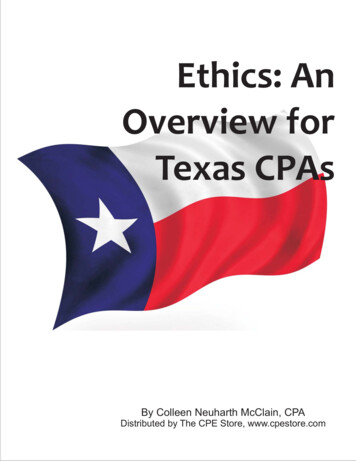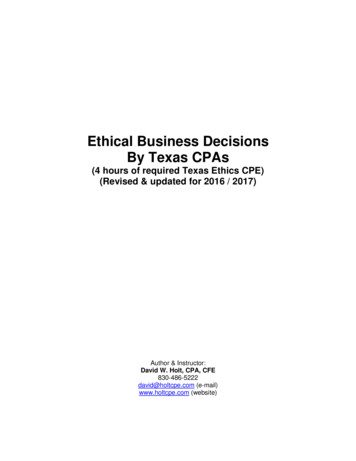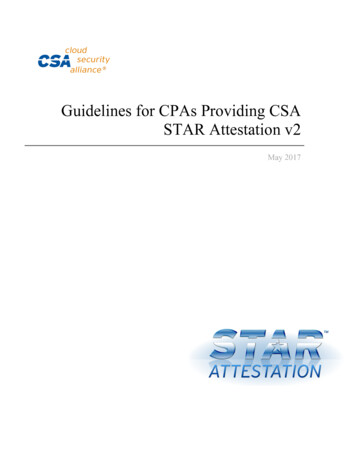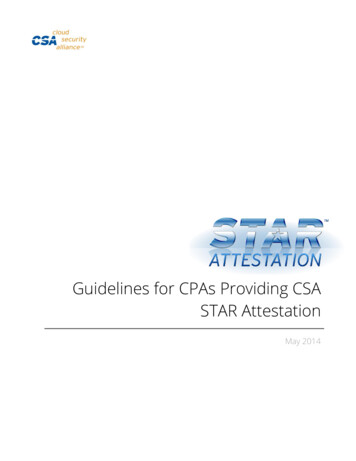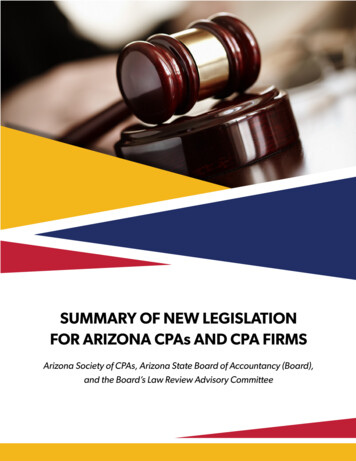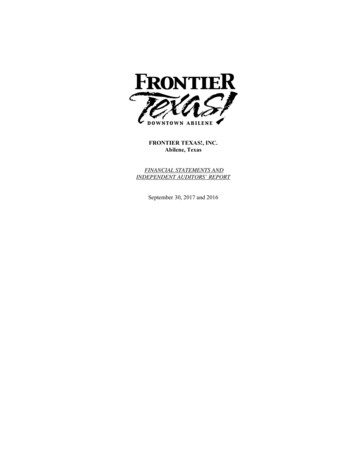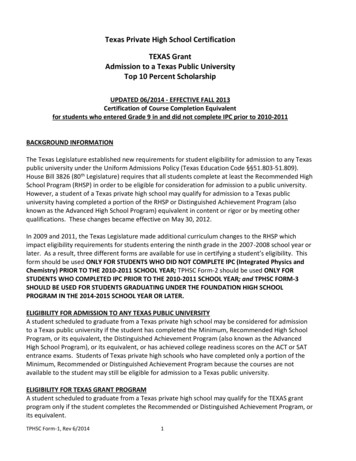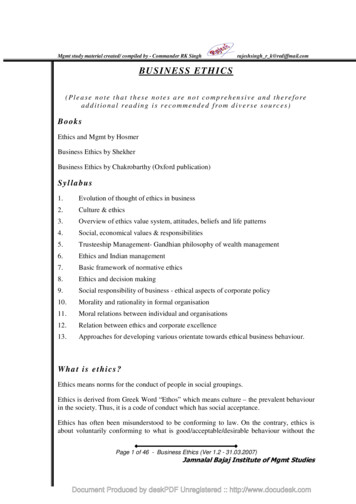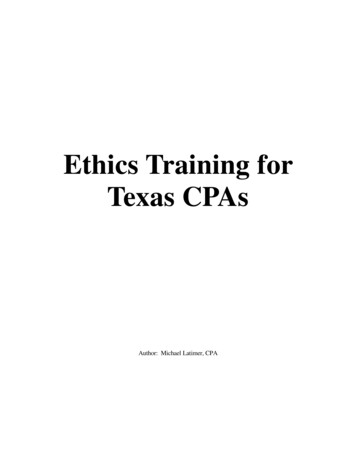
Transcription
Ethics Training forTexas CPAsAuthor: Michael Latimer, CPA
Ethics Training for Texas CPAsCopyright 2016 byDELTACPE LLCAll rights reserved. No part of this course may be reproduced in any form or by any means, without permission inwriting from the publisher.The author is not engaged by this text or any accompanying lecture or electronic media in the rendering of legal,tax, accounting, or similar professional services. While the legal, tax, and accounting issues discussed in thismaterial have been reviewed with sources believed to be reliable, concepts discussed can be affected by changesin the law or in the interpretation of such laws since this text was printed. For that reason, the accuracy andcompleteness of this information and the author's opinions based thereon cannot be guaranteed. In addition, stateor local tax laws and procedural rules may have a material impact on the general discussion. As a result, thestrategies suggested may not be suitable for every individual. Before taking any action, all references and citationsshould be checked and updated accordingly.This publication is designed to provide accurate and authoritative information in regard to the subject mattercovered. It is sold with the understanding that the publisher is not engaged in rendering legal, accounting, orother professional service. If legal advice or other expert advice is required, the services of a competentprofessional person should be sought.—-From a Declaration of Principles jointly adopted by a committee of the American Bar Association and aCommittee of Publishers and Associations.All numerical values in this course are examples subject to change. The current values may vary and may not bevalid in the present economic environment.
Course Instructions - How to use the MaterialsYou can review these materials on-line. You can also access via an IPAD or tablet.You can also print the materials and read it in that format if you prefer.Review/Explanations SectionThe EBook contains Review Questions section(s) that review the materials at the end of each significant chapter.The Review Questions are an Interactive requirement of NASBA and are included to assist you in understandingthe material better. They are NOT graded; however, you will find them useful in reinforcing the materials thatyou have read. The Explanations/Answers to the Review Questions sections are located at the end of the EBook.CPE Exam – Final AssessmentA copy of the CPE Exam is located at the end of the EBook.You may find it helpful to print out the paper exam and review it as you go through the course materials. Thepaper exam and the on-line exam contain the same questions. The advantage of using the online courseware isthat your exam is graded instantly. A certificate is generated once you have passed the exam. In most cases, thisis a score of 70% or better. NASBA does not permit review of exam answers until the exam is passed.You have one year from date of purchase to complete and pass the exam. You can retake the exam if need beduring that same time frame. You can also return and print certificates at a later date if the need arises.Course EvaluationOn the Course Materials website page, there is a link to a course evaluation. In addition, there is a link to thecourse evaluation in the email that we send containing your certificate. We would look to hear from you. Yourfeedback is helpful in revising and developing our courses.Logging on to Course Material & Exam SiteIf you wish to go to the on-line exam go to http://takeexams.cpaselfstudy.comand login using the student id and password you created at your time of purchase.If you forget your password, you can click the Recover Password link under the Login dialog box.An alternative way to get to the exam is to go to http://www.cpaselfstudy.com and simply click on the StudentLogin icon located at the top of the website and then login.Questions? – Contact Registrar@cpaselfstudy.com
Course Learning Objectives Identify the characteristics of ethics.Recognize ethical reasoning used by accountants.Differentiate between rulings and principles of the AICPA‘ Code of Professional Conduct.Identify the six principles and list the eleven rules of the AICPA Code of Professional Conduct.Identify independence and objectivity issues using the threats and safeguards approach, a conceptualframework.Recognize ethics rulings on independence.Recognize the Texas State Board of Public Accountancy Rules of Professional Conduct.Identify licensing and disciplinary mechanisms for Texas CPAs.
Table of ContentsCourse Learning Objectives . 4Chapter 1 Ethics and Ethical Reasoning. 1Learning Objectives . 1Ethics Defined . 1Ethical Reasoning and Accountants . 3Ethical Dilemmas in Accounting. 5Chapter 1 Review Questions . 8Chapter 2 AICPA Code of Professional Conduct . 9Learning Objectives . 9AICPA‘s Code of Professional Conduct . 9Summaries of the Six Principles.10Conceptual Framework – Threats and Safeguards Approach .11Summaries of the Eleven Rules .16Chapter 2 Review Questions .38Chapter 3 Texas Rules of Professional Conduct .39Learning Objectives .39Texas Rules of Professional Conduct .41Chapter 3 Review Questions .73Review Question Answers .75Chapter 1 Review Questions Feedback .75Chapter 2 Review Questions Feedback .76Chapter 3 Review Questions Feedback .79Glossary .82
Index .86Final Examination .88
Chapter 1Ethics and Ethical ReasoningLearning ObjectivesAfter studying this chapter, you will be able to: Identify the characteristics of ethics.Recognize ethical reasoning used by accountants.Ethics DefinedMerriam-Webster provides the following definitions of ethics: the discipline dealing with what is good and bad and with moral duty and obligationa set of moral principlesthe principles of conduct governing an individual or a groupa guiding philosophya set of moral issues or aspects (as rightness)Ethics is the ―science of morals‖. A moral is an accepted rule or standard of human behavior. The understandingof ―accepted‖ is ―accepted by society‖, and accepted only insofar as the behavior in question being behavior thataffects others in the society, even if only indirectly. The implication of this definition is therefore that privateactions that have no impact on others are a matter for personal morality, which is not of business or organizationalconcern.However, the distinction between personal morality and business morality may not always be so clearly defined.This is because individuals bring personal values to their jobs and to the real or perceived problems of moralchoice that confront them at work. Moral choices sometimes must be made because of tensions withinindividuals, between individuals, or between individuals and what they believe to be the values that drive theirorganizations.Furthermore, business organizations do not operate in a social vacuum. Because of the ways businessorganizations can and do affect the lives and livelihoods of society at large, some would argue that businessorganizations are kind of ―moral agents‖ in society. Therefore managers and general public alike often wrestlewith defining exactly what constitutes the ethical way of doing business, and what constitutes proper constraintson individual self-interests, and by whom shall these constraints be imposed.A further complexity results from the fact that businesses are increasingly becoming global in nature. Differentcountries have or seem to have vastly different customs and values. Understanding and assessing whether andhow these different cultural and ethical conflicts should be taken into account is often most difficult.1
Attitudes toward EthicsAmoral:Condone any actions that contribute to the corporate aim. Getting awaywith it is the key. No set of values other than greed.Legalistic:Obey the letter of the law but not the spirit of it, especially if it conflictswith profits. Ethics ignored until it becomes a problemResponsive:Take the view that there is something to gain from ethical behavior, Usingethics as a tool to attain corporate aim.Emerging:Ethical values becoming part of the culture. Codes of ethics being actiondocuments, and likely to contain statements reflecting core value,Ethical:Total ethical profile. Everything done is ethical, and the right thingalways done by everyone. The ideal.In general, a key focus of ethics is the concept of integrity (or honesty). Integrity in broad terms will imply that nobusiness-persons in the course of their business functions should be party to the falsification of any facts orinformation or make any statement which knowingly is misleading, false or deceptive in a material particular.Another major focus of ethics is professional competence and due care, which implies that business professionalsshould always perform their functions in accordance with law and regulations. In other words, businesstransactions and professional functions should not be undertaken unless one possesses the required competenceand technical skills.A more controversial focus is the area of freedom from conflicts of interests. The preferred position of many isthat one should always avoid concurrent involvement in any business, occupation or activity, which might resultin the compromising of integrity, objectivity and independence of decision making.In defining law and ethics and their relationship to each other, it is necessary to distinguish between moral andlegal rights and duties. Morally, a person's rights consist of claims that he can justly make to the conditions ofwell-being; his duties consist of what he can justly contribute to well-being. Legal rights and duties - that is,claims and obligations enforceable at law - may or may not be fully in harmony with prevalent moral opinionsystems in which law and ethics and religion are closely interwoven. The impact of moral opinion on law varieswith the type of political structure and influence of public opinion.In free societies, the ultimate justification of law is that it serves moral ends. However, the dependence of law onmoral principles must not be taken to imply that there is a set of moral principles, which can be laid down forguidance. However, most free societies are coming to be more or less consistent in principles that draw the linebetween law and morals. The task of ethics becomes two-fold: to bring out what is involved in the notion of aprinciple or norm of action and to recognize ideals that serve as agencies of guidance and control.2
A number of consistent principles recognized in modern society are the individual, responsibility and equity. Theend of law is to secure the greatest possible general individual self-assertion. In the Judeo-Christian ethic,responsibility is a given: the best ordering of human society in which the individual may come to full manhoodand satisfying existence. On the basis of equitable doctrine, we can say confidently that morality is inseparablefrom the legal order; that right and wrong is part of the legal order.Ethical Reasoning and AccountantsThe largest part of the prior research projects which have been done on ethical issues in accounting have generallyavoided theoretical discussions about "right and wrong" or "good and bad" choices. Instead, they have focused ondetermining whether or not accountants are ab
CPE Exam – Final Assessment A copy of the CPE Exam is located at the end of the EBook. You may find it helpful to print out the paper exam and review it as you go through the course materials. The paper exam and the on-line exam contain the same questions. The advantage of using the online courseware is that your exam is graded instantly. A certificate is generated once you have passed the exam. In most
